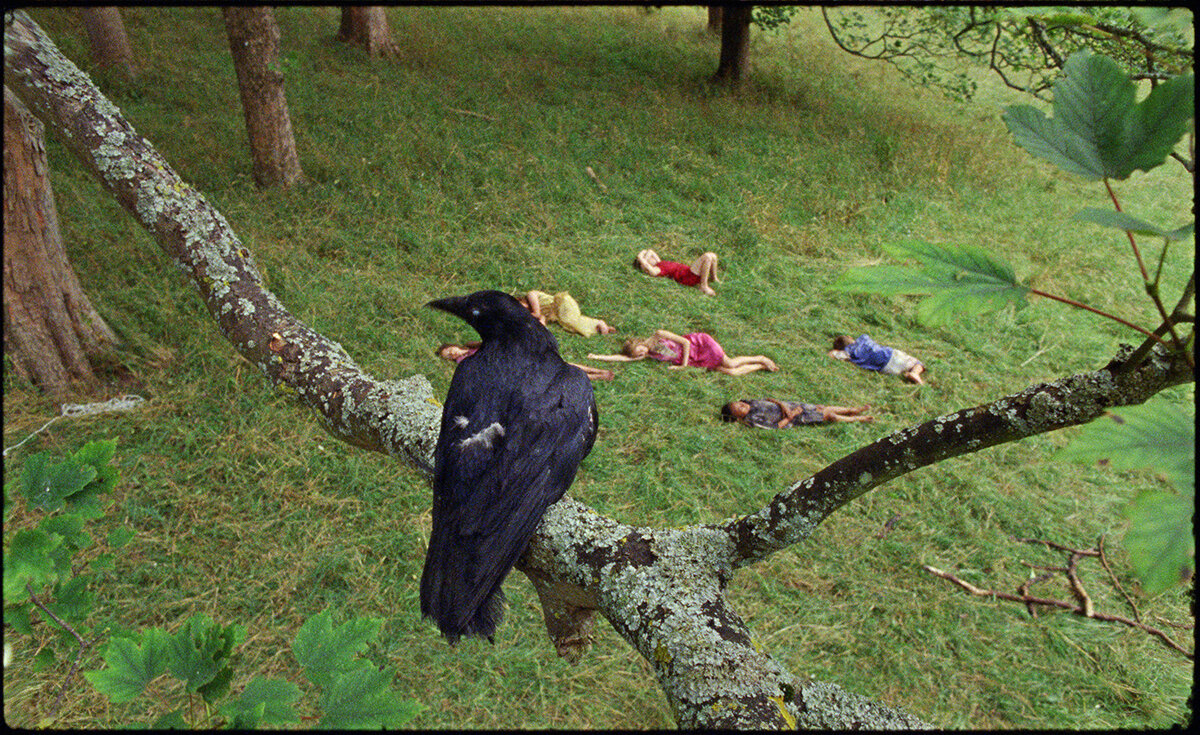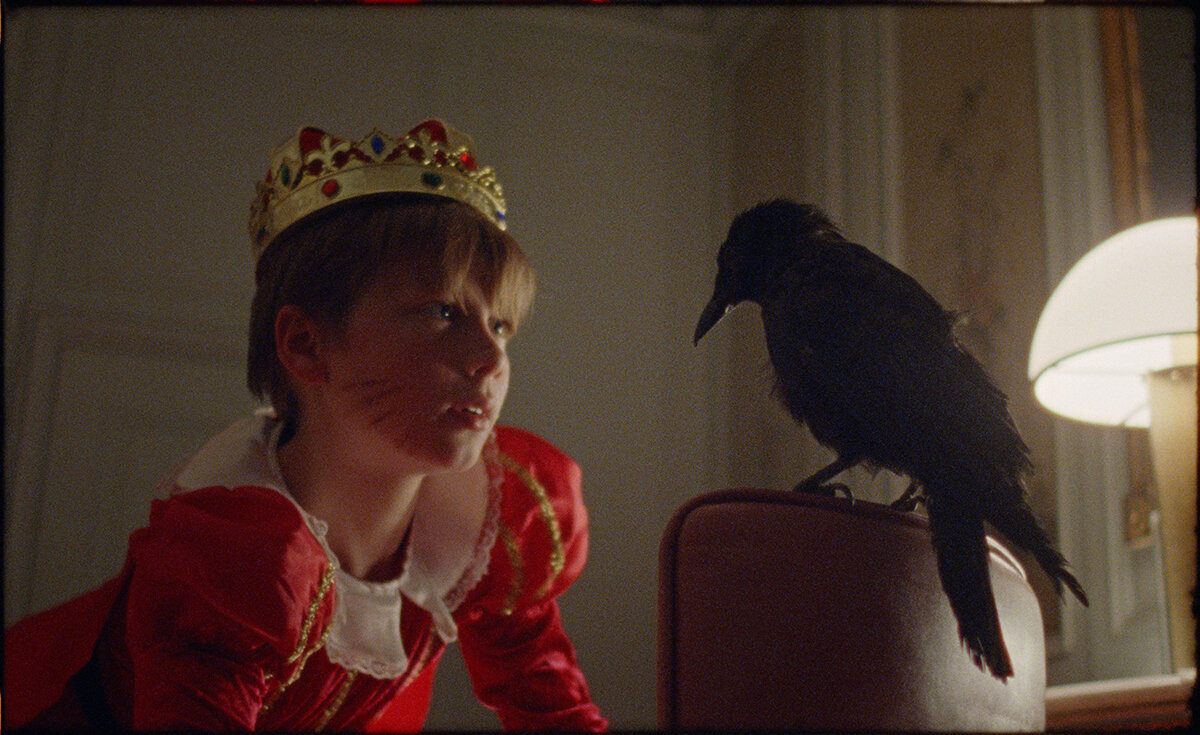text by Adam Lehrer
Marianna Simnett doesn’t get bored. The artist and filmmaker immerses herself in books, art, and her own psychology, lavishing in an elysium of the imagination populated by clinical aesthetics, myths, and ambiguities. Simnett absorbs countless references and liquidates them into her own world. Unlike her friend and co-screenwriter on The Bird Game, the writer/curator Charlie Fox, whose work vividly chronicles an encyclopedic knowledge of art, film and literature, Simnett strives to transmogrify her fascinations so that they adapt to her world. “I absorb everything but then I camouflage what I absorb,” says Simnett. “It all gets amalgamated into and regurgitated through my style.”
In Simnett’s new film The Bird Game, a mischievous and deceitful crow lures children into a deadly “game” by making appeals to their insidious boredom. “Crow” invites the kids to his house to play a game, “the bird game.” The children— having just arisen from a slumber—are easily lured with the promise of never having to sleep again. Of never having to withdraw from external stimuli again.
“Are you very, very hungry?” asks Crow (voiced by British actress Joanne Whalley). “YES!” enthuse the children. Famished for distraction, within the logic of The Bird Game, boredom is the deadliest of sins. It’s a physical illness, like in Todd Haynes’ Safe. It makes the children “dull boys,” like Jack Torrance in Kubrick’s The Shining.
Within the horror genre, illness seems to be a preexisting condition. Polish modernist, weird fiction writer Stefan Grabinski was drawn to supernatural horror primarily due to the illness that he carried with him his whole life. Born with tuberculosis of the bone, Grabinski “was an idealistic loner who strove for an understanding of the hidden forces of the world and the human mind,” according to Grabinski translator, Miroslaw Lipinski. Simnett, likewise, claims to have never felt at ease within her body. Her style is defined by a deliciously perverse amalgam of the scientific and bodily with an embrace of the fabled tales that populate the Jungian collective unconscious, “I’ve always sought language that helps me escape my body,” says Simnett. “That helps us escape the flesh of who we are.”
Oscillating between the mythic and the forensic, Simnett’s films often benefit from the influx of a chaotic element. An algorithmic outlier. An aspect that she can’t totally control or predict the outcome of. An unsettling atmosphere made more so by a persistent component of bedlam. Like in Beckett’s Watt, where the titular protagonist is so overwhelmed by the inexplicable nature of the mansion where he works that he eventually loses the verbal capacity to narrate his own story, Simnett’s films incorporate unforeseen forces that make the viewer lose the ability to comprehend their themes; this is seductively pandemonic cinema.
“Working with a live crow or unruly children as actors can have that same effect of Herzog attempting to lift a boat over a cliff in Fitzcarraldo,” says Simnett. “I don’t want to know everything that will happen on set before we make the film; it eliminates political or transformative potential.”
The Bird Game inaugurates a new direction in Simnett’s work. Though it isn’t without corporeal impact (clearly, a malignant crow eviscerating the flesh of young children still churns the stomach), it’s predominantly defined by a hypnotic fairy tale aesthetic that simultaneously dulls the splanchnic disturbances of the films’ carnal mutilations and introduces a perverse childishness into the narrative that yields a new dimension of the weird and eerie. This fantastical element has always been there, pushing Simnett’s work into the symbolic territory of the surrealist, but in The Bird Game emerges as the primary aesthetic of the work.
Simnett was commissioned to create the film with the idea that it’d be in conjunction with the concept of a Victorian era hospital and thought she’d make a film aligned with her typical bodily and medical themes/imagery. Simnett thought something felt wrong about the approach, that she had reached “the end of an era” with those themes, she says, and reoriented her cinematic focus. “I wanted to turn our gazes away from our physical selves,” says Simnett.
Literary critic and philosopher Julia Kristeva challenged Freud’s claim to have effectively treated Little Hans’ phobia of horses by unearthing the Oedipus complex. Instead, Kristeva suggests Freud reinforced Hans' phobia by giving language to a previously unnamable fear. The phobia doesn't disappear, but slides “beneath language,” says Kristeva. Similarly, The Bird Game explores how fairy tales give language to unnamable anxieties and demonstrates how these tales use the fantastical to comprehend reality. Sleep, for instance, becomes a perturbation, a state of sacrificed control and divorce from the distractions of wakefulness; in the film, Crow drugs the children with liquid opium and makes a boy drown a girl in a tub through hypnotic suggestion. The narrative visualizes common but difficult to verbalize fears. “The mythical aspect is always in conjunction with something unsettling and unreal,” says Simnett.
The Bird Game digests a host of references into Simnett’s visual language. The legacy of Sleeping Beauty—particularly older or more brutal versions of it, like 17th century Italian poet and fairy tale collector Giambattista Basile's Sun Moon and Talia or American metafiction novelist Robert Coover’s 1996 novel, Briar Rose—is digested into the film’s dreamily malevolent atmosphere. Henry James’ Turn of the Screw, Tim Burton’s Hansel and Gretel, Angela Carter’s The Bloody Chambers, Leonora Carrington’s writings, Marina Warner’s mythographical texts, and countless more references all emphasize Simnett’s fascination with the fairy tale’s ability to rationalize and make sense of trauma.
Simnett shoots the film’s set—the historic Waddesdon Manor—with a lack of reverence bordering on the satirical. She frames the house as a site of metaphysical transformation; she calls the house a “brain,” or a space with its own intention and desire. Crow calls it her nest, a place full of treats and secrets; as the children move up its floors, they grow further removed from their innocence. The brutality envisaged upon the children is made more palatable and less brutal by the devilish wit and rhetorical delivery of Crow, despite in many ways being an archetypal witch takes on the sarcasm and playfully mean tone of her creator co-Charlie Fox. Crow tells the children different fairy tales throughout the house before descending into murderous rage: “FLESH! FLESH!” screams Crow as she tears apart two girls trying to escape the game.
The film’s ending invites an ambiguous reading of the villainous Crow. Crow tells a story of when she was a young girl being chased through the woods by a raving boy, but was saved by a witch who turned her into a bird—like Princess Philomela and Queen Procne who were transformed into birds by the Gods of Olympus to escape the murderous rapist King Tereus—and Crow returns this favor by transforming the sole survivor of the Bird Game into a bird, delivering her from the trauma she’s endured and the future horrors of adulthood. “It’s an optimistic suicide of sorts,” says Simnett. “There’s a schism between who Crow is and who the girl is. A doubling.”
Though The Bird Game is a new avenue in Simnett’s body of work, it retains her practice’s singular focus on the fissure between fact and fiction. Simnett uses myth and artifice to rip holes into the fabric of the symbolic order and excavate the real of contemporary existence: violence, trauma, abuse, desire, sex, and transformation. Simnett says her art gives her a space to disregard morals, and see the world as it is, and also as it could be. Finding solace in the amorality of fairy tales, Simnett’s films allow us to bask in our darker impulses without judgment. She creates films that present danger—either to her in the sense that the filmmaking process could go badly (whether injecting Botox into her throat or using live crows as actors at historic estates) or to us in that we might see ourselves within these freakishly wicked images and narratives—which is what makes them so deliciously twisted.“Fairy tales become ways to exorcise a world without morals,” she says. “I always want that element in my films. I’m trying to create instability between fact and fiction. I don’t even see the difference between them.”
Click here to visit Marianna Simnett's to view previous films



